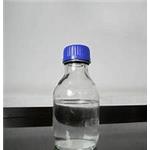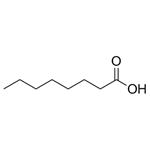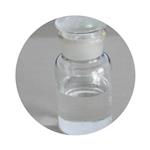- Octanoic acid
-

- $6.00 / 1KG
-
2024-04-13
- CAS:124-07-2
- Min. Order: 1KG
- Purity: More than 99%
- Supply Ability: 2000KG/Month
- Octanoic acid
-

- $0.00 / 500ml
-
2024-02-06
- CAS:124-07-2
- Min. Order: 1ml
- Purity: 0.995
- Supply Ability: 100 ton
- Octanoic acid
-

- $0.00 / 1kg
-
2023-12-29
- CAS:124-07-2
- Min. Order: 1kg
- Purity: 99%
- Supply Ability: 1000000
|
| | Octanoic acid Basic information |
| | Octanoic acid Chemical Properties |
| Melting point | 16 °C | | Boiling point | 237 °C(lit.) | | density | 0.91 g/mL at 25 °C(lit.) | | vapor density | 5 (vs air) | | vapor pressure | 1 mm Hg ( 78 °C) | | refractive index | n20/D 1.428(lit.) | | FEMA | 2799 | OCTANOIC ACID | | Fp | >230 °F | | storage temp. | 20-25°C | | solubility | 0.68g/l | | form | Liquid | | pka | 4.89(at 25℃) | | color | Clear colorless to yellow | | Specific Gravity | 0.910 (20/4℃) | | Odor | unpleasant odor | | PH Range | 3.5 | | PH | 3.97(1 mM solution);3.45(10 mM solution);2.95(100 mM solution); | | Odor Type | fatty | | explosive limit | 1%(V) | | Water Solubility | 0.68 g/L (20 ºC) | | JECFA Number | 99 | | Merck | 14,1765 | | BRN | 1747180 | | Dielectric constant | 3.2(18℃) | | Stability: | Stable. Incompatible with bases, reducing agents, oxidizing agents. Flammable. | | LogP | 3.05 at 20℃ | | CAS DataBase Reference | 124-07-2(CAS DataBase Reference) | | NIST Chemistry Reference | Octanoic acid(124-07-2) | | EPA Substance Registry System | Octanoic acid (124-07-2) |
| Hazard Codes | C,Xi | | Risk Statements | 34 | | Safety Statements | 26-36/39-45-36/37/39-25-27 | | RIDADR | UN 3265 8/PG 3 | | WGK Germany | 1 | | RTECS | RH0175000 | | Autoignition Temperature | >300 °C | | Hazard Note | Irritant | | TSCA | Yes | | HS Code | 2915 90 70 | | HazardClass | 8 | | PackingGroup | III | | Hazardous Substances Data | 124-07-2(Hazardous Substances Data) | | Toxicity | LD50 orally in rats: 10,080 mg/kg (Jenner) |
| | Octanoic acid Usage And Synthesis |
| Chemical Properties | Octanoic acid has a mildly unpleasant odor and a burning, rancid taste. It is also reported as having a faint, fruity–acid odor and slightly sour taste. As an eight-carbon compound, it is among the fatty acids considered to be of short or medium chain length. | | Physical properties | Caprylic acid, CH3(CH2)6COOH, also known as hexylacetic acid,n-octanoic acid, octylie acid, and octic acid, is a colorless, oily liquid having a mildly unpleasant odor and a burning, rancid taste. It is only slightly soluble in water (68 mg per 100 mL at 20°C). It is a natural component of coconut and palm nut oils and butter fat. Caprylic acid has also been identified in trace amounts in beer, brandy distillate, the essential oil of fermented Russian black tea leaves, and raw soybeans.It is used in manufacturing drugs and dyes. | | Occurrence | It is found naturally in the milk of various mammals, and it is a minor constituent of coconut oil and palm kernel oil. Octanoic acid has also been identified in trace amounts in beer, brandy distillate, the essential oil of fermented Russian black tea leaves and raw soybeans. | | Uses | Octanoic acid is a flavoring agent considered to be a short or medium chain fatty acid. It occurs normally in various foods and is commercially prepared by oxidation of n-octanol or by fermentation and fractional distillation of the volatile fatty acids present. It is used in maximum levels, as served, of 0.13% for baked goods; 0.04% for cheeses; 0.005% for fats and oils, frozen dairy desserts, gelatins and puddings, meat products, and soft candy; 0.016% for snack foods; and 0.001% or less for all other food categories. | | Uses | Octanoic acid (Caprylic acid) is an oily liquid with a slightly unpleasant rancid taste and used commercially in the production of esters used in perfumery and also in the manufacture of dyes. Octanoic acid is also a tremor-suppressing agent. | | Preparation | Octanoic acid is produced by fermentation and fractional distillation of the volatile fatty acids present in coconut oil. | | Application | Octanoic acid is widely applied in various fields, It is an antimicrobial pesticide used as a food contact surface sanitizer in commercial food handling establishments on dairy equipment, food processing equipment, breweries, wineries, and beverage processing plants. In addition, caprylic acid is used as an algaecide, bactericide, and fungicide in nurseries, greenhouses, garden centers, and interiorscapes on ornamentals. Products containing caprylic acid are formulated as soluble concentrate/liquids and ready-to-use liquids.
Caprylic acid is also used in the treatment of some bacterial infections. Due to its relatively short chain length it has no difficulty in penetrating fatty cell wall membranes, hence its effectiveness in combating certain lipid-coated bacteria, such as Staphylococcus aureus and various species of Streptococcus.
Octanoic acid is used commercially in the production of esters used in perfumery and also in the manufacture of dyes.
Some studies have shown that Caprylic acid is effective to excess calorie burning taken as a dietary supplement, resulting in weigh loss. | | Definition | ChEBI: Octanoic acid is a straight-chain saturated fatty acid that is heptane in which one of the hydrogens of a terminal methyl group has been replaced by a carboxy group. Octanoic acid is also known as caprylic acid. It has a role as an antibacterial agent, a human metabolite and an Escherichia coli metabolite. It is a straight-chain saturated fatty acid and a medium-chain fatty acid. It is a conjugate acid of an octanoate. | | Aroma threshold values | Detection: 910 ppb to 19 ppm. Aroma characteristics at 1.0%: waxy, dirty, sweaty and cheesy fatty, with
dirty oily and creamy dairy nuances. | | Taste threshold values | Taste characteristics at 10 ppm: creamy, waxy, dirty, sweaty, dairy cheeselike. | | Synthesis Reference(s) | The Journal of Organic Chemistry, 54, p. 5395, 1989 DOI: 10.1021/jo00283a044
Synthetic Communications, 19, p. 2151, 1989 DOI: 10.1080/00397918908052610 | | General Description | Octanoic acid appears as a colorless to light yellow liquid with a mild odor. Burns, but may be difficult to ignite. Corrosive to metals and tissue. | | Reactivity Profile | Octanoic acid reacts exothermically to neutralize bases. Can react with active metals to form gaseous hydrogen and a metal salt. May absorb enough water from the air and dissolve sufficiently in it to corrode or dissolve iron, steel, and aluminum parts and containers. Reacts with cyanide salts or solutions of cyanide salts to generate gaseous hydrogen cyanide. Reacts exothermically with diazo compounds, dithiocarbamates, isocyanates, mercaptans, nitrides, and sulfides to generate flammable and/or toxic gases. Reacts with sulfites, nitrites, thiosulfates (to give H2S and SO3), dithionites (SO2), to generate flammable and/or toxic gases and heat. Reacts with carbonates and bicarbonates to generate a harmless gas (carbon dioxide) but still heat. Can be oxidized exothermically by strong oxidizing agents and reduced by strong reducing agents. A wide variety of products is possible. May initiate polymerization reactions or catalyze (increase the rate of) reactions among other materials. | | Health effects | Taking Octanoic acid supplements is not recommended for people who are pregnant or breastfeeding. Caprylic acid supplements may cause mild stomach or digestive upset. People with frequent stomach problems should consult a healthcare professional before taking caprylic acid supplements. | | Safety Profile | Moderately toxic by
intravenous route. Mildly toxic by ingestion.
Mutation data reported. A skin irritant.
Yields irritating vapors that can cause
coughmg. When heated to decomposition it
emits acrid smoke and irritating fumes. | | Source | Octanoic acid is widespread in plant oils, free and as glycerides. It is also present in apples, bananas, orange juice and peel, pineapple, cognac, calamus, blue cheeses, cheddar cheese, Swiss cheese, feta cheese, and other cheeses. It is found naturally in various mammals' milk and is a minor constituent of coconut and palm kernel oil. Octanoic acid is found in many foods, including salad, mango, ice cream, and anise. | | Solubility in water | Octanoic acid is an oily liquid with a slightly unpleasant rancid-like smell that is minimally soluble in water. Octanoic acid contains a long alkyl chain which represents its organic part. It will be insoluble in inorganic solvents like water as it is has a long organic part. |
| | Octanoic acid Preparation Products And Raw materials |
|